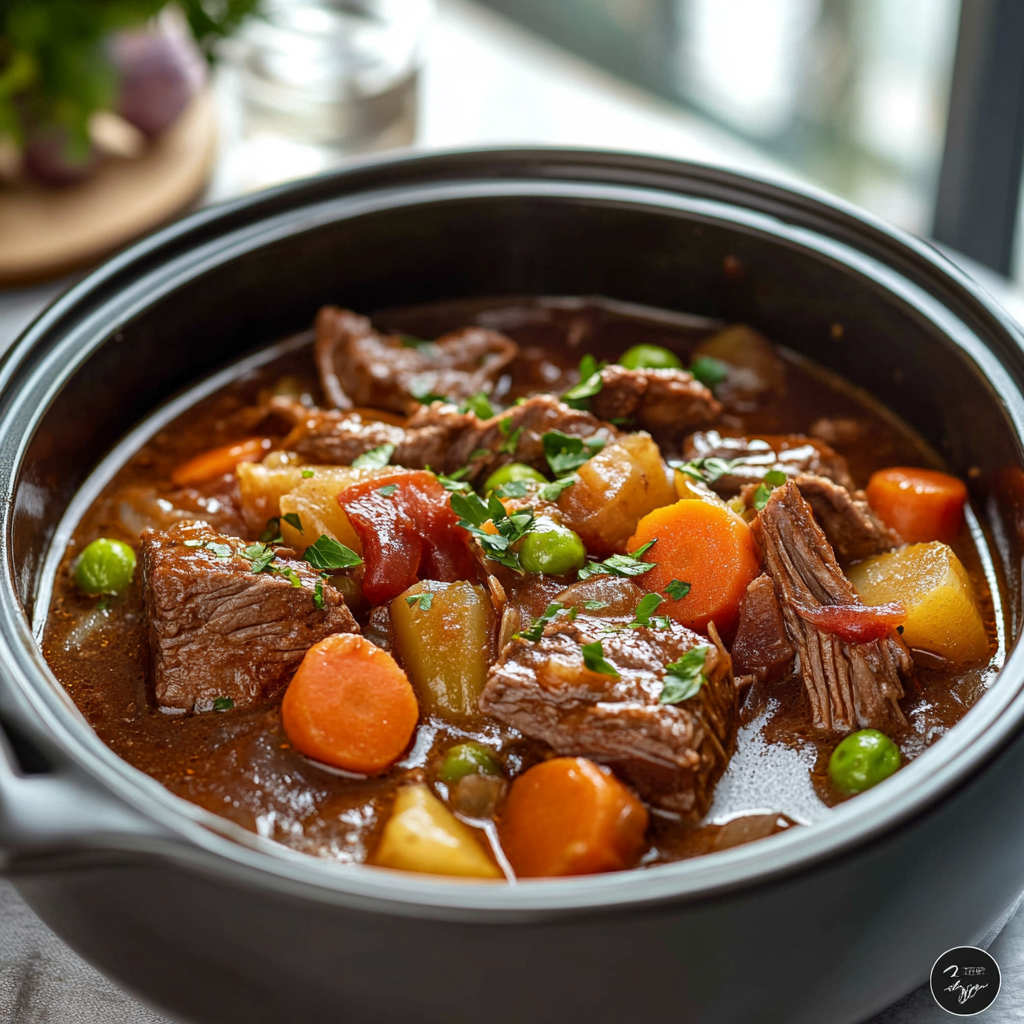Introduction and Quick Summary
Slow Cooker Beef Stew is a classic dish that captures the essence of comfort food. As the weather cools down, there’s nothing quite like coming home to a warm bowl of beef stew after a long day. This dish combines tender chunks of beef with hearty vegetables simmered in a rich broth. The beauty of this recipe lies not just in its flavor but also in its simplicity; using a slow cooker allows the ingredients to meld together beautifully while you go about your day.
This recipe is perfect for busy families or anyone looking to whip up an easy yet satisfying meal. With just a few key ingredients and minimal prep time, you can enjoy an incredibly flavorful dish that will leave everyone asking for seconds. Plus, it’s versatile! You can adjust the seasonings or add your favorite vegetables to make it your own. In this article, we will walk you through the main ingredients needed to create this delicious slow cooker beef stew and provide detailed step-by-step instructions.
Get ready to savor each bite of this warm and inviting meal that is bound to become a staple in your household. Let’s dive into the world of slow cooking and discover how to make this delightful beef stew!
Main Ingredients
Beef Chuck Roast
The star of our Slow Cooker Beef Stew is the beef chuck roast. This cut is known for its rich flavor and tenderness when cooked low and slow. For this recipe, you’ll need about 2 pounds of boneless beef chuck roast, cut into 1-inch cubes. The marbling in the chuck roast helps keep it moist during cooking, leading to melt-in-your-mouth pieces that enhance the overall dish.
Carrots
Carrots add both sweetness and color to your stew. You will need about 3 medium-sized carrots, peeled and cut into thick slices. Their natural sugars caramelize during cooking, providing depth to the broth while still retaining some texture that balances well with the tender meat.
Potatoes
Potatoes are essential for making the stew hearty and filling. Use about 4 medium potatoes (Yukon Gold or Russet work well), peeled and chopped into large chunks. They absorb flavors from the broth while adding starchiness that thickens it as they cook down.
Onion
Onions provide a base flavor for your Slow Cooker Beef Stew. You’ll want one large onion, chopped finely. Sautéing the onions before adding them to the slow cooker can deepen their sweetness even further; however, you can skip this step if you’re short on time.
Garlic
Garlic elevates any dish with its robust flavor profile. Use 3 cloves of garlic minced for this recipe; it infuses the broth with aromatic notes that complement all other ingredients beautifully.
Beef Broth
For a flavorful base, use 4 cups of low-sodium beef broth. The broth carries all those wonderful flavors throughout cooking while keeping sodium levels manageable.
Tomato Paste
Adding 2 tablespoons of tomato paste enhances the richness of the broth while providing acidity that balances out flavors perfectly.
Herbs and Spices
Seasoning is key! Use 1 teaspoon of dried thyme, 1 teaspoon of dried rosemary, salt and pepper to taste (about 1 teaspoon each). These herbs infuse warmth into the dish while allowing each ingredient’s unique flavors to shine through.
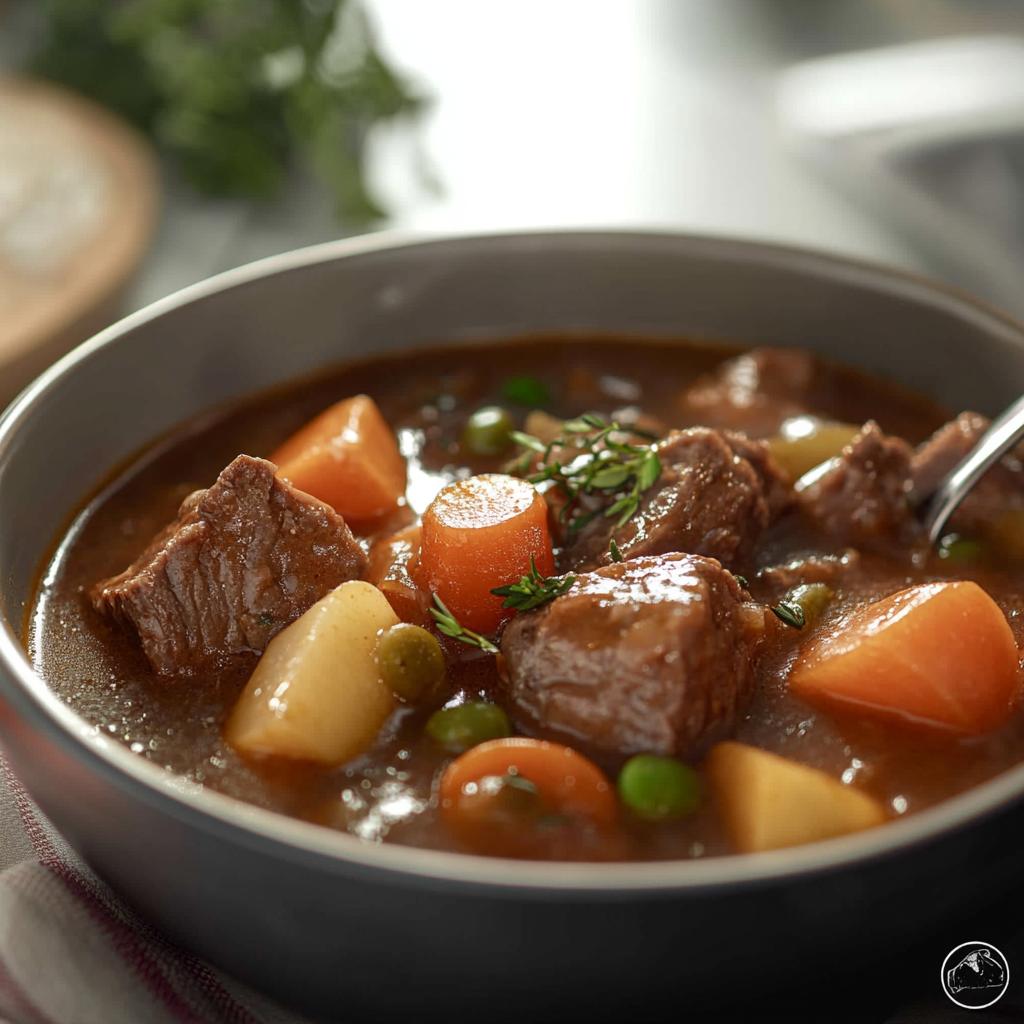
How to Prepare Slow Cooker Beef Stew
Step One: Prepare Your Ingredients
Start by prepping all your ingredients so everything is ready when it’s time to assemble your stew. Begin with cutting 2 pounds of beef chuck roast into 1-inch cubes—this ensures even cooking throughout. Next, peel and slice three medium-sized carrots into thick rounds; their size will help them hold up during long cooking times without turning mushy.
Now turn your attention to potatoes—peel four medium potatoes (Yukon Gold or Russet) before chopping them into large chunks; these will absorb flavors nicely without disintegrating too quickly in your slow cooker.
Finely chop one large onion; if you prefer a sweeter taste from caramelized onions instead—feel free to sauté them in olive oil for about five minutes on medium heat before proceeding with your recipe.
Lastly, mince three cloves of garlic which contribute essential aroma! Having everything prepped beforehand will streamline your cooking process later on since you’ll be able just toss everything into your slow cooker effortlessly at once!
Step Two: Start Layering in Your Slow Cooker
Once all ingredients are prepared, grab your trusty slow cooker! Begin by placing half of the diced potatoes at the bottom followed by half of the chopped carrots—this layering technique ensures they won’t get overly mushy during prolonged cooking times.
Next goes half of those perfectly cubed pieces from earlier (approximately one pound) followed by half of that finely chopped onion then sprinkle on minced garlic next! You can repeat this layering pattern using remaining vegetables before finishing off with rest portioned meat layered above all else creating an impressive visual display within pot itself!
Now let’s season things up: pour in four cups low-sodium beef broth over top mixture generously before adding two tablespoons tomato paste plus spices—thyme rosemary salt & pepper gently mixing everything together ensuring full coverage across all components present!
Step Three: Cook Low & Slow
With everything layered nicely inside pot now comes best part: setting yourself up for success! Cover slow cooker tightly ensuring no steam escapes out during lengthy process ahead then plug it into wall outlet selecting either low heat setting (for around eight hours) OR high heat setting (for approximately four hours)—both methods yield tender results but timing varies based on personal preference/lifestyle needs!
It’s important not peek until last hour approaches as doing so interrupts heating cycle potentially affecting final outcome so resist temptation! If desired feel free check tenderness using fork around hour mark—it should pierce easily indicating doneness achieved successfully!
If using high setting simply reduce time until desired texture reached—remember once finished allow cooling slightly before serving allowing flavors meld further enhancing sensory experience enjoyed by everyone gathered around table together enjoying heartwarming meal shared amongst loved ones!
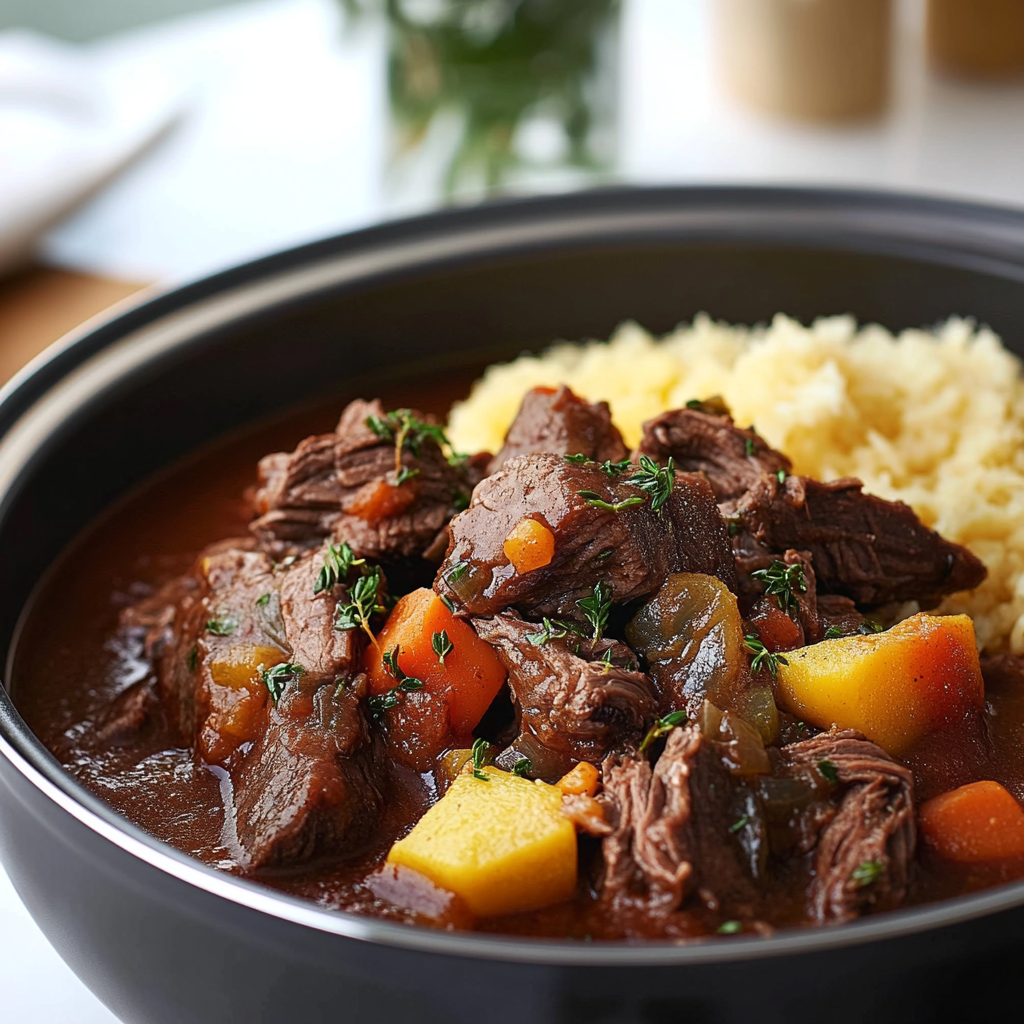
Serving and Storing Tips
Serving Suggestions
When serving your Slow Cooker Beef Stew, presentation matters! Ladle generous portions onto bowls ensuring each includes an ample amount of both meat along with veggies showcasing vibrant colors throughout dish itself creating visually appealing feast eyes behold instantly making mouths water anticipation awaits first bites taken eagerly!
To elevate experience even further consider offering crusty bread slices alongside—perfect for soaking up delicious juices left behind after devouring stews themselves! Alternatively rice or noodles could act as bed beneath each portion adding extra dimension filling comfort food vibes resonate deeply within souls gathered together sharing good times around table filled laughter joy abound from such simple pleasures life brings forth us daily reminding cherish moments spent together alongside family friends alike!
Let garnishing options inspire creativity too: sprinkle fresh parsley atop servings right before digging in adds freshness brightness elevating overall appearance significantly transforming rustic feel elegantly presenting inviting ambiance surrounding meal shared amongst loved ones gathered close celebrating life’s little joys found everyday moments spent together enjoying homemade culinary delights like these ones created through love care intention poured freely crafted lovingly kitchen spaces where memories made flourish grow flourish thrive flourish eternally cherished forevermore held dear hearts!!
Storing Leftovers
If you have leftovers after enjoying this delicious meal don’t fret—they’re perfect preserving future enjoyment convenience wise too! Allow any remaining portions cool completely before transferring them airtight containers refrigerate up within two hours after initial serving period concluded safely preserving freshness maximize shelf life potential maintain quality intact longer terms prevent spoilage occurring prematurely ruining efforts put forth originally creating scrumptious feast everyone indulged relished savored thoroughly first time around!!
Refrigerated properly leftover stews typically last three days maximum although freezing options exist extending longevity significantly beyond limits imposed fridge alone offering possibilities indulging cravings whenever desired later dates ahead too!! To freeze simply ladle cooled portions right away individual freezer-safe bags label date contents clearly ensure ease access next time urge strikes wanting indulge comforting bowl hearty goodness once again revisiting flavors familiar loved ones embraced fondly cherished moments shared around tables warmed hearts nourished bellies alike feeling fulfilled satisfied content knowing home-cooked meals created special occasions memories made linger sweetly long after eaten!!
In conclusion embracing preparation simplicity approach offers nourishing satisfaction every step way journey undertaken crafting delightful dishes ultimately bringing people closer together through deliciousness shared experiences formed lasting connections built grown stronger minds hearts alike unite enjoying warmth coziness familiar comforts provided thoughtfully prepared meals like these simple yet impactful ways celebrate joys everyday life moments created cherished forevermore!!
Mistakes to avoid
One of the most common mistakes when preparing Slow Cooker Beef Stew is using the wrong cut of meat. Many people opt for lean cuts, thinking they will produce a healthier dish. However, tougher cuts like chuck roast or brisket are ideal for slow cooking because they become tender and flavorful as they break down over time. Choosing the right meat ensures that your stew has a rich texture and depth of flavor.
Another mistake is overcrowding the slow cooker. While it may be tempting to load it up with more ingredients, doing so can lead to uneven cooking. The moisture released from the vegetables and meat needs space to circulate for optimal results. If you have too many ingredients, consider making a larger batch in two separate cookers or cooking in stages for even better flavors.
Not browning the meat before adding it to the slow cooker is another oversight many make. Browning creates a caramelized crust that enhances the dish’s overall flavor profile. This step adds depth and complexity to your Slow Cooker Beef Stew, making it significantly more enjoyable. Always take the time to sear your beef on high heat before placing it into the slow cooker.
Over-seasoning at the beginning can also ruin your stew. Ingredients like herbs and spices can intensify during long cooking times, leading to an overpowering flavor. It’s wise to add only half of your seasoning at first and then adjust towards the end of cooking. Taste testing near the end allows you to achieve a balanced flavor that doesn’t overwhelm your palate.
Finally, neglecting to layer ingredients properly can affect your stew’s texture and taste. Placing root vegetables at the bottom helps them cook evenly while keeping meats on top retains moisture and flavor. This layering technique is crucial for achieving perfect results in your Slow Cooker Beef Stew.
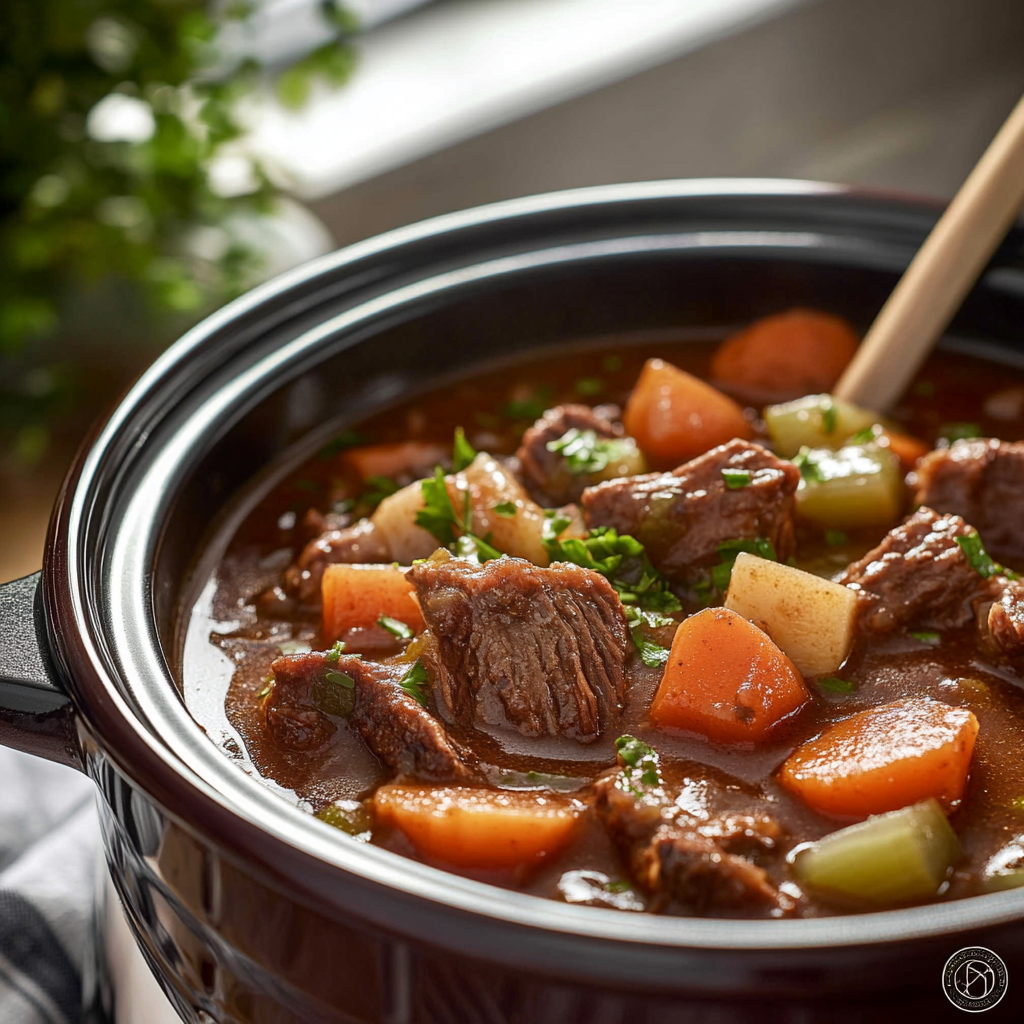
Tips and tricks
To ensure a successful Slow Cooker Beef Stew, one effective tip is to use fresh herbs instead of dried ones when possible. Fresh herbs release oils and flavors that enhance dishes significantly during long cooking periods. If using dried herbs, remember that they are more concentrated; thus, reduce their quantity accordingly for optimal taste.
Another valuable trick is to add a splash of acid such as vinegar or citrus juice towards the end of cooking. This brightens up flavors and balances richness from fats in your stew. A tablespoon of red wine vinegar or fresh lemon juice added just before serving can elevate your dish dramatically without overpowering it.
Keep an eye on the liquid levels throughout cooking; adding too much broth can dilute flavors while too little may lead to burning or drying out ingredients. Aim for just enough liquid to cover your main components without submerging everything completely. Monitoring this balance will enhance overall taste and maintain proper textures in your stew.
Consider including seasonal vegetables for added nutrition and flavor diversity in your Slow Cooker Beef Stew. Carrots, potatoes, and parsnips work wonderfully together, but you could also experiment with squash or sweet potatoes based on availability during particular seasons.
Lastly, allow ample time for cooling after cooking before storing any leftovers in an airtight container in the fridge or freezer. Rapid cooling prevents bacterial growth while maintaining food quality over time, ensuring you enjoy delicious leftovers without compromising safety.
Suggestions for Slow Cooker Beef Stew
For a well-rounded Slow Cooker Beef Stew, consider incorporating different types of stock or broth based on personal preferences or dietary requirements. Using beef stock adds richness; however, vegetable stock provides lighter notes while still maintaining great flavors when combined with other ingredients like mushrooms or tomatoes.
Adding umami-rich ingredients such as soy sauce or Worcestershire sauce can deepen flavors remarkably well in this dish type as well. A couple of tablespoons mixed into your broth elevates savory notes without overwhelming sweetness from vegetables present within the recipe.
Experimenting with various aromatics beyond typical onions and garlic can also create unique twists on traditional recipes; try shallots or leeks for sweeter undertones that complement beef perfectly! Including these alternatives allows creativity during preparation without straying too far from classic stews’ roots.
If looking for ways to enhance texture further within this comforting dish type – consider thickening agents like cornstarch slurry towards desired consistency once cooked through! This easy addition achieves velvety textures quickly without additional calories commonly found in heavier creams used elsewhere.
Lastly, don’t forget about garnishing! Fresh parsley sprinkled atop servings not only improves presentation but brings brightness into each bowl served beautifully alongside heartwarming comfort food classics like Slow Cooker Beef Stew!
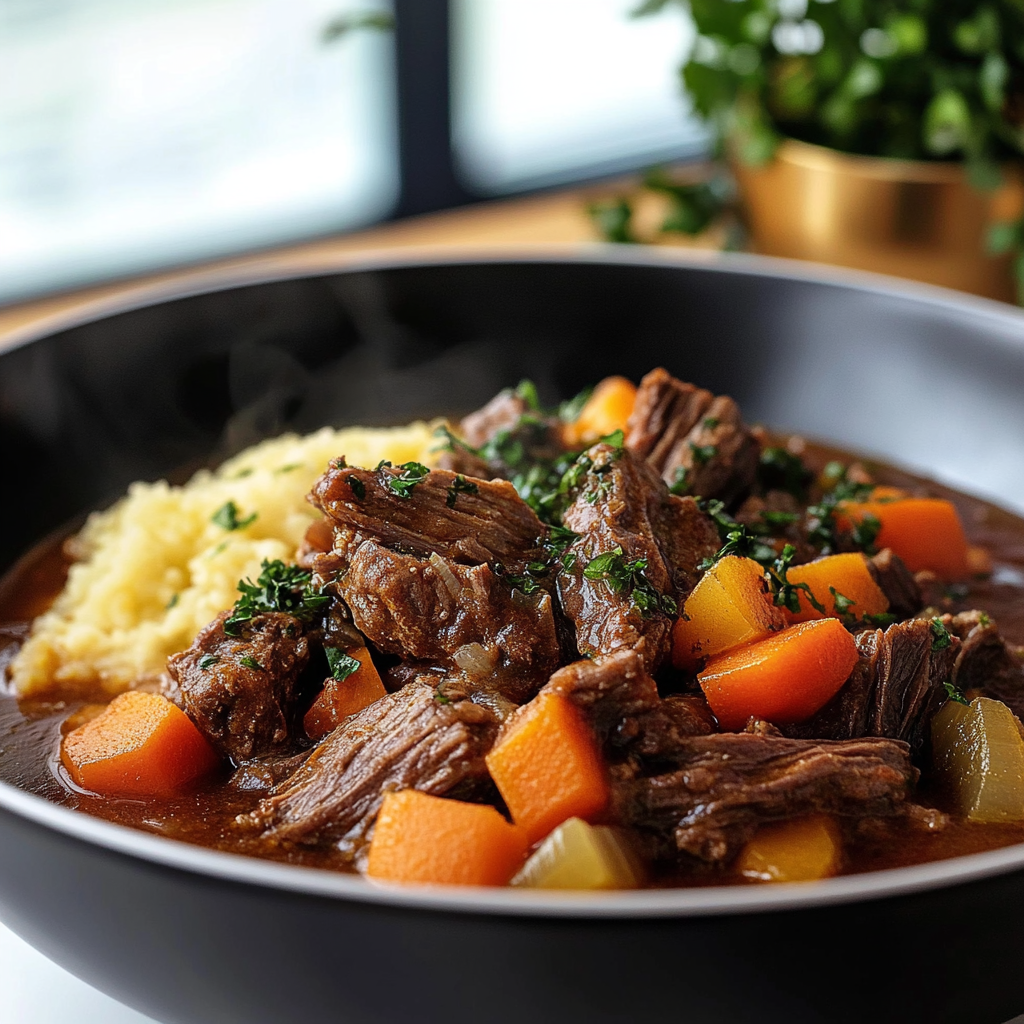
FAQs
What makes Slow Cooker Beef Stew different from regular beef stew?
Slow Cooker Beef Stew differs primarily due to its cooking method—slow cooking allows flavors to meld together beautifully over extended periods while keeping meats tenderized through low heat application! Traditional methods often require stovetop techniques where attention and constant stirring are needed; however, slow cookers offer convenience by allowing meals prepared early in the day ready by dinner time effortlessly!
Can I use frozen beef in my Slow Cooker Beef Stew?
Using frozen beef directly in a slow cooker isn’t recommended since it raises safety concerns regarding temperature control during initial stages of heating! Instead, thaw meats overnight beforehand inside refrigerators before adding them into pots; ensuring safe handling practices promote healthier outcomes while maintaining desired textures throughout entire dish experience!
How long should I cook my Slow Cooker Beef Stew?
Cooking times vary depending upon settings chosen (high vs low) along with ingredient quantities utilized—generally speaking though: low heat options typically take around 8 hours whereas high heat settings require approximately 4-6 hours until fully cooked through! Always check tenderness levels prior serving up bowls filled with hearty goodness—cooking longer often yields even richer flavors enjoyed by all!
Can I add beans or lentils into my Slow Cooker Beef Stew?
Absolutely! Beans & lentils provide extra protein sources elevating nutritional value significantly—be mindful not include them too early since they require less time compared traditional meats do; adding them last hour ensures perfect tenderness achieved without mushiness ruining textures throughout entire stew!
Is it possible to make my Slow Cooker Beef Stew gluten-free?
Certainly! To create gluten-free versions simply substitute all-purpose flour typically used as thickener within recipes utilizing cornstarch instead—it functions similarly yielding same satisfying results minus unwanted gluten content found otherwise! Additionally confirm other ingredients being utilized (such as broths/sauces) align accordingly ensuring no hidden sources exist causing cross-contamination issues encountered regularly among those adhering strictly gluten-free diets!
What sides pair well with Slow Cooker Beef Stew?
Pairing sides such as crusty bread options (like baguettes) perfects soaking up rich juices left behind after serving bowls filled with comforting stews! Alternatively opting towards creamy mashed potatoes provides classic accompaniments known globally—salads featuring fresh greens balance hearty dishes elegantly showcasing vibrant colors alongside rich comforting flavors enjoyed universally by diners everywhere indulging together happily sharing moments around tables filled warmth love laughter joy always found naturally shared amongst families friends celebrating life togetherness!
Conclusion
In summary, crafting an exquisite Slow Cooker Beef Stew requires attention to detail throughout every stage—from selecting appropriate cuts of meat down through careful seasoning levels maintained consistently throughout processes—this ensures delightful result achieved ultimately enjoyed around dining tables shared amongst family friends alike!
Avoid common pitfalls such as overcrowding vessels during preparations while remembering essential tips like incorporating fresh herbs enhancing aromatic profiles uniquely suited individual preferences based upon tastes developed over years gone by enjoying various cuisines across cultures worldwide today!
Understanding how specific suggestions impact final outcomes gives cooks confidence experimenting new ideas keeping meals exciting continually evolving enhancing culinary skills perfected over time enjoying delicious homemade comfort foods created lovingly shared warmly amongst loved ones reminding us all why we cherish moments spent together around tables filled nourishment bringing warmth hearts souls alike nourishing bodies minds spirits endlessly through laughter memories formed lasting impressions cherished forevermore!

